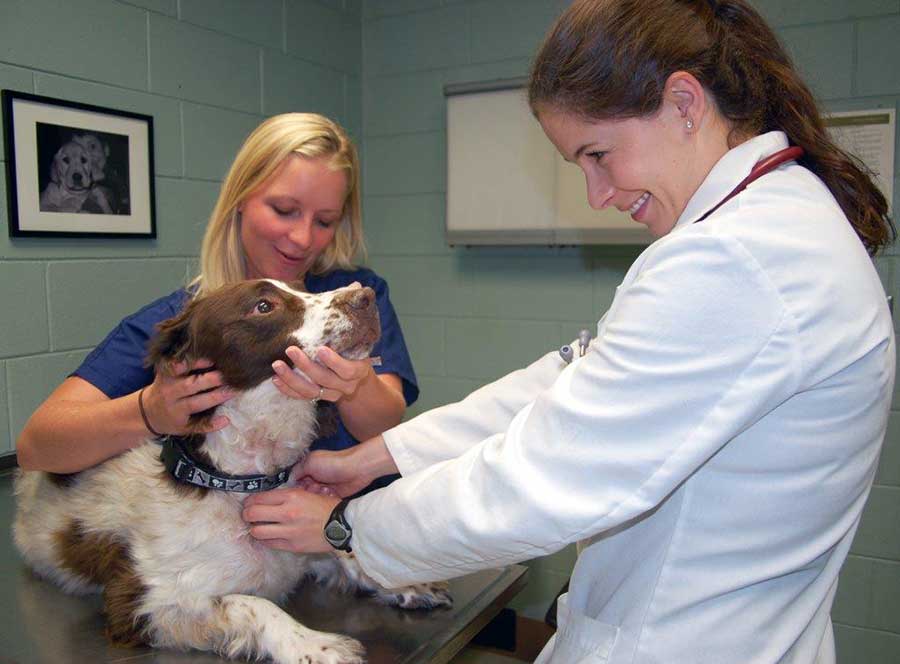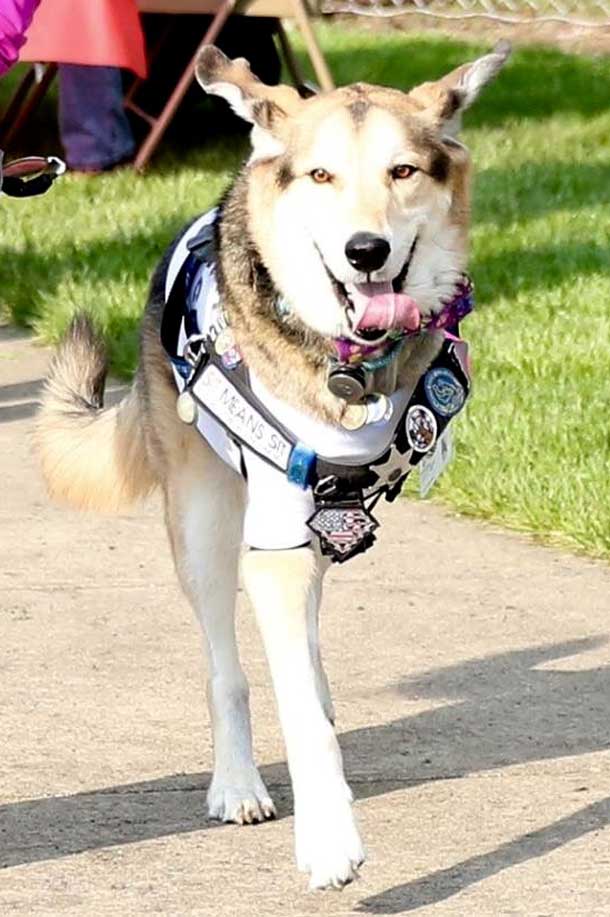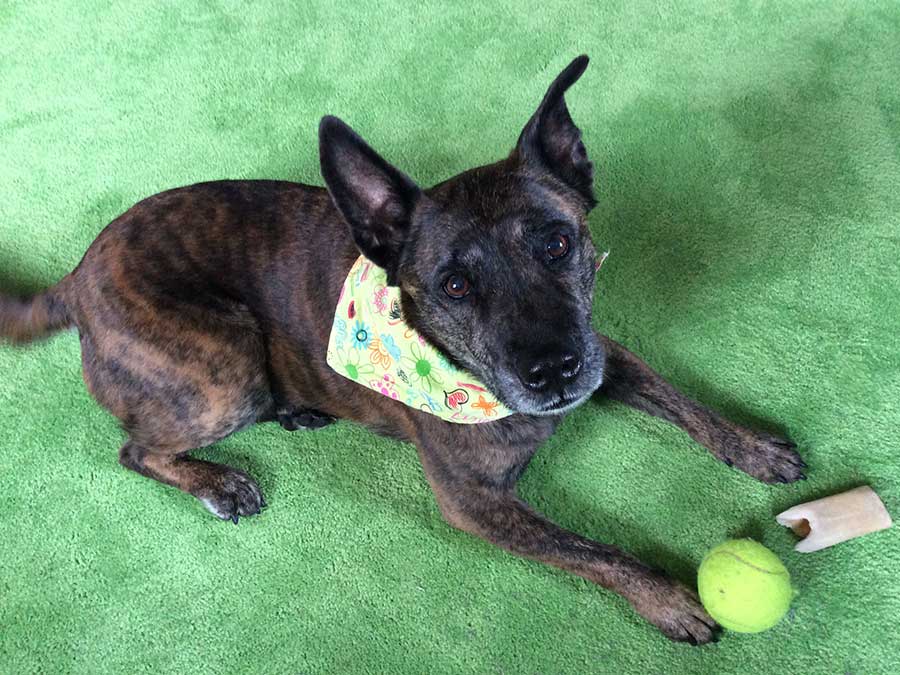
Helping Dogs—and Humans—with Cancer: NCI’s Comparative Oncology Studies
July 10, 2019, by NCI Staff
Dogs are, no doubt, man’s best friend. So, it’s no surprise that people will do almost anything for their dogs. But what can a person do if their dog is given a devastating diagnosis of cancer?
One option is to enroll the pet in an NCI-supported clinical trial testing a new cancer treatment. The goal of these trials, offered by veterinary medical schools around the country, is to find new treatments that preserve dogs’ quality of life and maximize their time with their families.
“These [dogs] are not lab animals, they are our patients,” said Toby Hecht, Ph.D., deputy director of NCI’s Division of Cancer Treatment and Diagnosis, who oversees some of the canine studies.
The trials have another benefit that pet owners may not expect: Providing insight into how the treatments and approaches being studied in dogs may be translated to help people with cancer.
That’s because the biology of humans and dogs, as well as the tumors that grow in each species, are similar in many ways. What’s more, cancer treatments that are safe and effective in dogs often work well in people, too.
Since 2003, NCI has been using information from studies of canine cancer to help guide studies of human cancer and vice versa—a field known as comparative oncology. Two NCI efforts, the Comparative Oncology Program (COP) and the Pre-medical Cancer Immunotherapy Network for Canine Trials (PRECINCT), facilitate trials of new therapies for different types of cancer in pet dogs, as well as laboratory studies to learn more about the basics of canine cancer.
“Pet dogs benefit from what we do because we learn about their cancer and that can ultimately help identify better treatments for them,” said Amy LeBlanc, D.V.M., director of the Comparative Oncology Program in NCI’s Center for Cancer Research. “We see the work that we do as an opportunity to help both dogs and people.”
How to Enroll Your Dog in an NCI-Supported Trial
If your dog has cancer and you are interested in enrolling him or her in an NCI-funded clinical trial, please call or email the contact person listed on the following pages:
Like Owner, Like Dog
It’s an old joke that, after a while, humans begin to look like their pets. Unfortunately, the similarities also extend to cancer. Dogs can develop many of the same types of cancer as humans, such as brain, lung, skin, and bone cancer.
Humans and pet dogs share the same living spaces, so they are exposed to some of the same environmental factors that cause cancer. Plus, cancer in both species can take years to develop, and in many cases, its growth is often driven by similar genetic mutations.
And not only does the cancer spread, or metastasize, from one body part to another in both humans and dogs, it usually spreads to the same organs such as the lungs and liver. Furthermore, our immune system (which can help and hinder cancer growth) works a lot like dogs’ do.
Because of these important similarities, studying pet dogs with naturally occurring cancers provides researchers with valuable clues about human cancer, Dr. LeBlanc said. Comparative oncology studies offer a different perspective than studies of artificially created cancers in lab animals such as mice and rats, she added.
But “there is no one model that is perfect for understanding cancer,” noted Cheryl London, D.V.M., Ph.D., of Tufts University, who is a member of COP and PRECINCT. “The more models we have, the better able we will be to identify and optimize approaches for cancer treatment and prevention.”
Why Enroll Your Dog in a Clinical Trial?
Although opting for an experimental treatment for a beloved family member may sound scary, there are several advantages to enrolling your dog in an NCI-supported clinical trial.
One benefit is that clinical trials provide access to cutting-edge therapies that would otherwise not be available.
And unlike human trials—which sometimes require that patients have cancer that has returned after standard treatment (recurrent cancer)—dogs, having few or no standards of care, can be enrolled in a trial any time after being diagnosed with cancer. Participating in a trial doesn’t exclude a pet from getting conventional treatments after the study ends, Dr. London noted.
The cost of care is another advantage. Whereas treatment received at a regular vet’s office is generally paid for out of pocket, NCI-funded trials typically offer substantial, if not complete, financial support for the cost of care, Dr. LeBlanc pointed out. Some NCI trials are sponsored by Morris Animal Foundation, a charity for animal health research.
All NCI-supported trials are rigorously reviewed to ensure that they meet standards for animal welfare and scientific merit. And dog owners don’t need to worry about their pet being away from home for too long. Dogs that participate in trials typically visit the clinical trial site only for outpatient or short-stay treatment and follow-up visits.
How Dog Studies Benefit Humans
One major way that comparative oncology studies help humans with cancer is by quickening the pace of drug development—an expensive and lengthy process.
Before researchers can test an experimental drug in humans, they first have to determine whether it is safe and effective in animals—usually mice. But findings in mice don’t always reflect how a drug will work in humans and, as a result, only a fraction of experimental drugs that work in lab studies end up advancing through clinical trials to FDA approval.
Although no animal can perfectly model exactly how a drug will act in humans, some scientists believe that studies in dogs may provide a better indicator of a drug’s potential in humans than studies in other animals.
“The dog turns out to be a good representative model for a lot of [human] diseases,” said PRECINCT member M. Renee Chambers, D.V.M., M.D., of the University of Alabama at Birmingham.
Dog studies can not only lead to insights into the safety and efficacy of a drug, but also help address questions about the drug’s optimal dose and how often it should be given, Dr. LeBlanc explained. Having this information can streamline the approach for human trials, she added.
In 2015, for example, an NCI-supported trial tested an experimental drug called NHS-IL12in pet dogs with melanoma. The study determined the drug’s optimal dose, side effects, how it is absorbed and broken down, and confirmed its mechanism of action. It also showed that the drug partially shrank the tumors of two dog patients.
The findings led James Gulley, M.D., Ph.D., of NCI’s Center for Cancer Research, and his colleagues to initiate a first-in-human clinical trial of NHS-IL12 in people with advanced solid tumors. The treatment appeared to work and caused only mild side effects that resolved quickly.
The dog study “provided important proof-of-principle about the clinical activity of the agent in a spontaneous tumor, rather than an artificial animal model,” said Dr. Gulley. That helped the first-in-human trial get the green light, he added.
Dr. Gulley is currently leading a multisite study of NHS-IL12 in combination with another drug, avelumab (Bavencio), for people with advanced solid tumors.
Helping Kids with Bone Cancer
The COP consists of a network of 24 veterinary schools across the United States and Canada. Three of the network's ongoing clinical trials focus on osteosarcoma, a type of bone cancer that develops in young children and large-breed dogs.
Because osteosarcoma is relatively rare in kids, it takes a lot of time to recruit enough participants for clinical trials, which can hinder researchers’ ability to develop new therapies. But a few years ago, an NCI-supported study showed that the genetic features of osteosarcoma in dogs and humans are so similar it’s hard to tell them apart, Dr. LeBlanc said.
COP researchers are hopeful that initial studies in dogs with osteosarcoma will help speed up the process of developing new therapies for children with this disease. To further this goal, COP leaders work closely with NCI researchers who study childhood osteosarcoma to ensure that the canine studies have the potential to impact care for children.
One of the canine osteosarcoma trials is testing a vaccine that teaches immune cells to attack cancer cells. The vaccine is given after the dog’s diseased limb has been surgically removed (what’s known as adjuvant treatment).
And at the NIH Clinical Center, researchers are developing tools that reveal, in real-time, what nutrients canine osteosarcoma tumors are absorbing (just like the rest of the body, tumors need a constant supply of food to fuel their growth). They hope to identify a nutrient that the cancer cells depend on and develop a treatment that eliminates it.
The researchers plan to take the results of these and other molecular studies and “offer that information to the pediatric osteosarcoma community to help them figure out whether these approaches could be adapted for children,” Dr. LeBlanc said.
Exploring Immunotherapy Combinations
While immunotherapies are highly effective for some forms of cancer, there is still room for improvement. Scientists are hopeful that immunotherapy combinations may help fill some of those gaps. But the number of possible combinations is staggering, and it would be nearly impossible to test them all in human trials. Once again, pet dogs have stepped in to help.
PRECINCT, part of the Cancer MoonshotSM, was formed to facilitate studies of pet dogs that have the potential to aid cancer immunotherapy development for humans. The network is currently testing different kinds of immunotherapies, and their combinations, in pet dogs with glioma, bone cancer, lymphoma, and skin cancer.
The researchers also carry out lab studies to figure out how the experimental treatments affect cancer cells and immune cells at the molecular level, and to look for biomarkers of treatment response, explained Connie Sommers, Ph.D., the NCI program officer for the network.
For example, Dr. Chambers and her colleagues are combining an immune checkpoint inhibitor with an oncolytic virus in pet dogs with glioma. As the virus infects and kills cancer cells, the debris released by dying cells may help attract cancer-killing immune cells.
At the same time, Dr. Chambers and her colleagues at the University of Alabama are running trials of the oncolytic virus in adults with glioma and a similar virus in children with glioma.
“We can compare outcomes from concurrent human and pet dog studies, but, most importantly, we can compare genomics” of the tumors to look for shared mutations, she said. “It’s the ultimate example of translational research.”
In another trial, researchers at the Cummings School of Veterinary Medicine at Tufts University in Massachusetts are testing different immunotherapy combinations in dogs with a type of blood cancer called diffuse large B-cell lymphoma (DLBCL).
Although standard first-line therapy for DLBCL is quite effective, the treatment eventually stops working for about 40% of patients, and for those who are cured, it can lead to chronic side effects, explained Dr. London, the trial’s leader. But it’s difficult to test promising new therapies in patients that have just been diagnosed with cancer becaue it's unethical to not offer them a highly effective standard treatment. Instead new treatments are usually tested in patients whose DLBCL has come back after several lines of treatment, she said.
Standard treatment for dogs with DLBCL is similar to that of humans. However, the treatment doesn’t work as well for dogs, so “we have the ability to explore novel regimens up-front,” she explained. The goal is to find a promising immunotherapy combination that they can then test head-to-head against the standard treatment.
They also plan to do in-depth analyses of dog patients who have dramatic and long-lasting responses (so-called exceptional responders) to see if they can identify molecular features that predict a good response to the treatment.
Bringing Cancer Researchers Together
Another great thing about NCI’s comparative oncology programs is that they bring researchers together, said Dr. London. The veterinary oncology community “was relatively siloed,” she said, but these programs “connected it, and allowed people to communicate and collaborate.”
The programs connect researchers who study cancer in pet dogs with those who study the disease in humans, said Dr. Hecht. “This is probably the first time that there’s been a concerted effort to pull veterinary oncologists into the larger cancer research community,” she added.
And Dr. Hecht hopes to foster even more collaboration, with plans to build a database for different kinds of data generated by all types of canine cancer studies. She and her colleagues recently began building a prototype of the database, called the Integrated Canine Data Commons.
Their ultimate goal is to build the canine database as a node within NCI’s main repository of human cancer data, the Cancer Research Data Commons (CRDC), so that researchers can make comparisons between human and dog cancers more easily.
“It’s going to be publicly available, so researchers can look at these [data] and devise new hypotheses to be tested,” Dr. Hecht said.
New hypotheses may lead to new treatment approaches, and that could mean that some dogs will get more time to play with their humans, and some humans may get more time to cuddle with their dogs.

























.png)









No hay comentarios:
Publicar un comentario